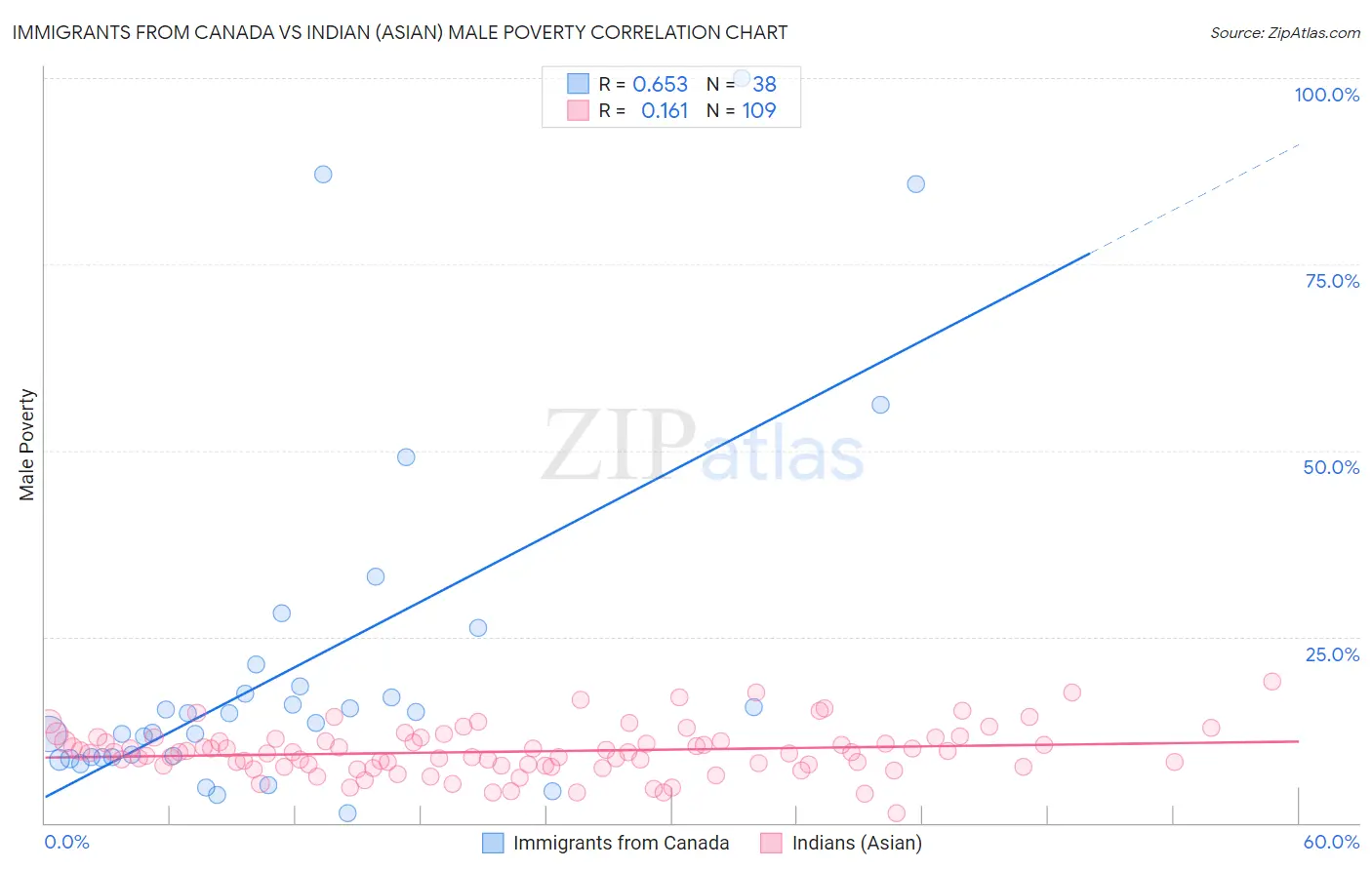Immigrants from Canada vs Indian (Asian) Male Poverty
COMPARE
Immigrants from Canada
Indian (Asian)
Male Poverty
Male Poverty Comparison
Immigrants from Canada
Indians (Asian)
10.2%
MALE POVERTY
97.1/ 100
METRIC RATING
72nd/ 347
METRIC RANK
10.4%
MALE POVERTY
94.9/ 100
METRIC RATING
90th/ 347
METRIC RANK
Immigrants from Canada vs Indian (Asian) Male Poverty Correlation Chart
The statistical analysis conducted on geographies consisting of 458,819,233 people shows a significant positive correlation between the proportion of Immigrants from Canada and poverty level among males in the United States with a correlation coefficient (R) of 0.653 and weighted average of 10.2%. Similarly, the statistical analysis conducted on geographies consisting of 494,421,628 people shows a poor positive correlation between the proportion of Indians (Asian) and poverty level among males in the United States with a correlation coefficient (R) of 0.161 and weighted average of 10.4%, a difference of 1.5%.

Male Poverty Correlation Summary
| Measurement | Immigrants from Canada | Indian (Asian) |
| Minimum | 1.3% | 1.3% |
| Maximum | 100.0% | 19.1% |
| Range | 98.8% | 17.7% |
| Mean | 21.2% | 9.6% |
| Median | 14.1% | 9.5% |
| Interquartile 25% (IQ1) | 8.8% | 7.7% |
| Interquartile 75% (IQ3) | 18.3% | 11.1% |
| Interquartile Range (IQR) | 9.5% | 3.5% |
| Standard Deviation (Sample) | 23.5% | 3.2% |
| Standard Deviation (Population) | 23.2% | 3.2% |
Demographics Similar to Immigrants from Canada and Indians (Asian) by Male Poverty
In terms of male poverty, the demographic groups most similar to Immigrants from Canada are European (10.2%, a difference of 0.010%), Immigrants from Asia (10.2%, a difference of 0.080%), Immigrants from Eastern Europe (10.2%, a difference of 0.16%), Carpatho Rusyn (10.2%, a difference of 0.16%), and Dutch (10.2%, a difference of 0.17%). Similarly, the demographic groups most similar to Indians (Asian) are Immigrants from Denmark (10.4%, a difference of 0.020%), Cambodian (10.4%, a difference of 0.030%), British (10.4%, a difference of 0.070%), Northern European (10.4%, a difference of 0.17%), and Immigrants from Eastern Asia (10.4%, a difference of 0.20%).
| Demographics | Rating | Rank | Male Poverty |
| Europeans | 97.1 /100 | #71 | Exceptional 10.2% |
| Immigrants | Canada | 97.1 /100 | #72 | Exceptional 10.2% |
| Immigrants | Asia | 97.0 /100 | #73 | Exceptional 10.2% |
| Immigrants | Eastern Europe | 96.9 /100 | #74 | Exceptional 10.2% |
| Carpatho Rusyns | 96.9 /100 | #75 | Exceptional 10.2% |
| Dutch | 96.9 /100 | #76 | Exceptional 10.2% |
| Immigrants | Belgium | 96.8 /100 | #77 | Exceptional 10.3% |
| Irish | 96.8 /100 | #78 | Exceptional 10.3% |
| Immigrants | North America | 96.5 /100 | #79 | Exceptional 10.3% |
| English | 96.4 /100 | #80 | Exceptional 10.3% |
| Belgians | 95.9 /100 | #81 | Exceptional 10.3% |
| Egyptians | 95.9 /100 | #82 | Exceptional 10.3% |
| Immigrants | Sweden | 95.7 /100 | #83 | Exceptional 10.3% |
| Czechoslovakians | 95.6 /100 | #84 | Exceptional 10.3% |
| Immigrants | England | 95.5 /100 | #85 | Exceptional 10.4% |
| Immigrants | Eastern Asia | 95.3 /100 | #86 | Exceptional 10.4% |
| Northern Europeans | 95.2 /100 | #87 | Exceptional 10.4% |
| Cambodians | 95.0 /100 | #88 | Exceptional 10.4% |
| Immigrants | Denmark | 95.0 /100 | #89 | Exceptional 10.4% |
| Indians (Asian) | 94.9 /100 | #90 | Exceptional 10.4% |
| British | 94.8 /100 | #91 | Exceptional 10.4% |